Last Word
Milton Bradley, 1985For 2 to 4 Players
Object
Score fhe most points by 1) picking up letter tiles to make words; 2) isolating opponents; and 3) making the last word.Contents
1 playing grid with gameboard insert 92 letter tiles (see letter distribution, below, for the number of each letter tile included in the game) 4 blank tiles 4 retainers 4 colored pawns 1 label sheet 1 instruction sheetLetter Distribution
A x 8 B x 2 C x 3 D x 4 E x 12 F x 3 G x 2 H x 4 I x 6 J x 1 K x 1 L x 3 M x 3 N x 5 O x 7 P x 3 Qu x 1 R x 5 S x 5 T x 5 U x 2 V x 1 W x 2 X x 1 Y x 2 Z x 1
Game Setup
1. THE GRID: The grid, shown in Figure 1, contains 100 game squares: 92 letter squares and 8 WILD squares. The 8 WILD squares are X-shaped.Along each side of the grid is a letter tile storage row containing 10 storage compartments. During the game, players place letter tiles here which count toward their final scores. Each compartment in the row holds 5 letter tiles.
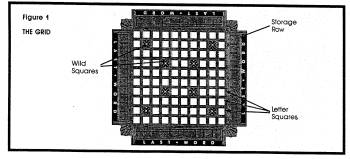
2. SECURING THE GAMEBOARD: Attached to the grid is a cardboard gameboard, whioh must be further secured to the grid before game setup continues. To secure the gameboard to the grid place the grid upside down on a flat surface. Make sure the gameboard is fitted securely into the 9 plastic tabs around its edges. Then twist the 4 round retainers off the runner, and press a retainer down on each of the 4 grid pegs as shown in Figure 2. Be sure to push each retainer down firmly against the bottom of the gameboard.
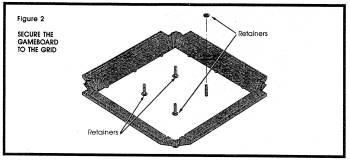
3. APPLYING THE LABELS: Each of the 4 LAST WORD labels shows a different colored dot, which indicates where the label should be placed. To apply the labels to the grid, first place the grid rightside up. Then peel one label at a time off the label sheet, and carefully apply it to the open area under the storage row on each side of the grid, clockwise in the following order: red dot, blue dot, yellow dot, green dot. See the box bottom, or Figure 3. for proper label placement.

4. THE LETTER TILES: Carefully break the 96 tiles off the 4 runners, then discard the empty runners. Put the 4 blank tiles aside; if necessary, you can use them later to replace lost or damaged tiles.
5. SETUP FOR GAME PLAY: To set up the assembled grid for a game, place the tiles in the game box, and mix them up. Then pick up the letter tiles at random and place one tile letterside up in each of the 92 letter squares on the grid. Do not place a letter tile on any of the 8 WILD squares.
Letter tile setup should be a joint effort by all players, and should be done quickly and completely at random. Place the letter tiles randomly to face any of the 4 sides of the gameboard, as shown in the sample setup illustration (Figure 3).
6. DRAWING YOUR PAWN: Each player draws a pawn at random out of a closed or raised container, so that no player knows in advance which color pawn he or she will use. Depending on the number of players in the game, draw from the following pawns:
2-Player Game: Draw from the red and yellow pawns only; set the blue and green pawns aside.
3-Player Game: Draw from the red, blue, and yellow pawns; set the green pawn aside.
4-Player Game: Draw from all 4 pawns.
Once you’ve drawn your pawn, take a seat at the side of the gameboard with the color dot on the label that matches your color pawn (the player with the red pawn sits at the red dot label, etc.)
7. Keep a dictionary nearby as a definitive reference source in case of challenges.
How To Make Words
Throughout the game, players make words by moving their pawns onto, then picking up, the letter tiles on the grid. Rules for making words are as follows:ADJACENT GAME SPACES: Make words by moving your pawn from one letter tile or WILD square to an adjacent letter tile or WILD square. Adjacent letter tiles are shown in Figure 4.
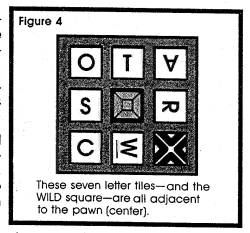
You can also “wrap around” the grid to adjacent letter tiles, as explained in WRAPPING AROUND THE GRID, on page 5.
BEGINNING AND ENDING A WORD: Each word must begin with a letter tile or WILD square adjacent to your pawn. After you make a word, leave your pawn on the last square used to make the word — either on a WILD square, or in place of the last letter tile used.
LETTER TILES AND WILD SQUARES: To make a word, you must move your pawn from square to adjacent square in the correct letter sequence. Each letter in the word you make must be adjacent to the previous letter tile or WILD square used to make the word.
A WILD square can be used to represent any letter in the word you make. You can use a WILD square more than once to make a word. RESTRICTIONS: You cannot use a WILD square to represent two consecutive letters in a word, And you cannot make a one-letter word using a WILD square. Although one-letter words are allowed, each word you make must use at least one letter tile.
Figure 5 shows a broader view of the game squares shown in Figure 4. As the player controlling this pawn, you may decide to make the word “train,” using a WILD square to represent the letter “n.” Your pawn would then remain on the WILD square.
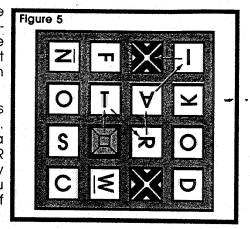
EMPTY GAME SQUARES: Pawn movement is restricted to letter tiles and WILD squares only. Once a letter tile has been removed from a letter square on the grid (see REMOVING YOUR WORD FROM THE GRID, below), the empty game square is out of play, which means you cannot move your pawn onto it for the rest of the game.
At the end of a turn, a pawn is either on an empty game square, or on a WILD square. To make a word, your pawn cannot move onto, or pass over, another player’s pawn.
WRAPPING AROUND THE GRID: You may “wrap around” the grid to begin a word, or to continue a word in progress. This means you can move your pawn off one side of the grid and onto an adjacent letter tile on the opposite side. This feature is illustrated on the box bottom, where the red pawn is shown making the word “cast.”
When you wrap around the grid to make a word, you can enter the opposite side of the grid to any one of three letter files: the letter tile directly opposite the last tile used, or the tile on either side of the opposite tile, as shown in Figure ó.
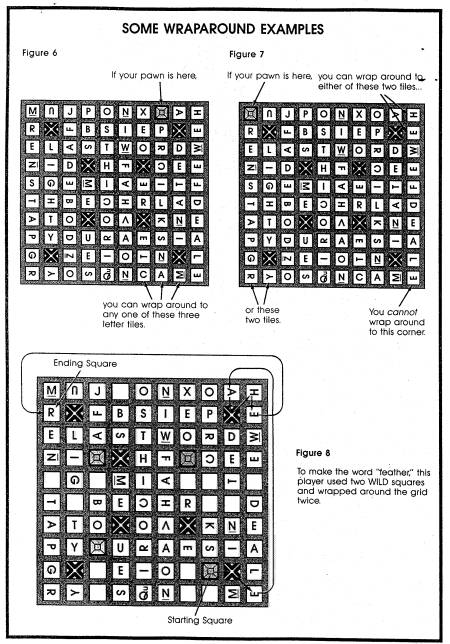
You can wrap around the grid from a corner letter tile. As shown in Figure 7, you can wrap around to either of two opposite sides of the grid from a corner tile; but there are only two tiles on each opposite side which are considered adjacent to a corner tile. Note: You cannot wrap around to the opposite diagonal corner of the grid; the letter tile on the opposite corner is not considered adjacent to a corner tile.
One more rule about wrapping around the grid: you can wrap around as many times as you wish to make a word. Figure 8 shows a pawn wrapping around the grid twice to make a word.
REMOVING YOUR WORD FROM THE GRID: Your pawn is especially designed to pick up the letter tiles you use to make a word. As you make a word, press your pawn on each letter tile to pick it up, then remove it from the bottom of the pawn and place it in your storage row.
YOUR STORAGE ROW: Just above the LAST WORD label on your side of the grid is a letter tile storage row with 10 separate compartments. Each compartment holds 5 letter tiles. As you remove a word from the grid, store the letter tiles you picked up in one or more of these compartments.
Game Play
1. THE FIRST TURN: The player who drew the red pawn takes the first turn. Play then continues to the left in a clockwise direction.On your first turn, make a word by moving your pawn onto any leffer tile in the first row directly in front of you. Your first word must start with a letter tile from your front row; then you can move to an adjacent tile — or wrap around the grid — to continue your word.
2. FOLLOWING TURNS: On each turn following your first turn, begin a word on a letter tile or WILD square adjacent to your pawn’s location on the grid.
3. MAKING YOUR WORD: On your turn, look at the grid and decide which word you want to make, Then make your word according to the following sequence:
A. Announce the word you plan to make, so that all players are aware of it.
B. Spell the word, and indicate which letter tiles (and WILD squares, if any), you plan to use.
C. Move your pawn onto each letter tile as you make your word, and remove the tile from the grid.
D. Place the letter tiles you pick up in your storage row.
E. Leave your pawn on the last square used to make the word.
4. NO PASSING! Last Word is a survival game, each player dropping out when he or she is unable to make a word. Passing a turn is not allowed: if you can’t make a word, you’re out of the game, as explained further in Rules 7 and 8.
5. LEGAL VS. ILLEGAL WORDS: We suggest you use the most comprehensive dictionary available as a guide, and agree to abide by it in case of challenges (explained in Rule 6). However, though they might be listed in your dictionary, we suggest you call the following words illegal:
• Words which are always capitalized.
• Words requiring a hyphen.
• Words requiring an apostrophe.
• Abbreviations and symbols.
• Prefixes and suffixes unable to stand alone.
• Foreign words that don’t appear in your dictionary.
6. CHALLENGES: If the spelling or legality of a word is in question (refer to Rule 5 for illegal words), any player can challenge the word before the next player begins making a word.
To settle a challenge, consult your dictionary. If the word is in your dictionary and not disallowed according to Rule 5; or if the word was challenged on the basis of spelling and is spelled correctly according to your dictionary, the challenger loses with no penalty.
If the challenged word is illegal according to Rule 4; or if it does not appear in your dictionary or is spelled incorrectly according to your dictionary, the challenger wins. The challenged player must replace the letter tiles on the grid and cannot make another word on that turn.
7. GETTING ISOLATED: If another player cuts off your pawn from any adjacent letter tiles, you’re isolated.
Your pawn can become isolated by another player’s pawn in either of the following two ways:
• TRUE ISOLATION: You’re a victim of true isolation if another player leaves you with no letter tiles to move onto, either immediately adjacent to your pawn, or adjacent to a neighboring WILD square. Figures 9A and 9B show true isolation.
• BLOCKING: You’re also isolated if another player blocks your pawn’s only passage to adjacent letter tiles by moving onto a neighboring WILD square. Even though there are letter tiles adjacent to the WILD square, you can’t move your pawn onto them Figure 9C shows isolation by blocking a WILD square.
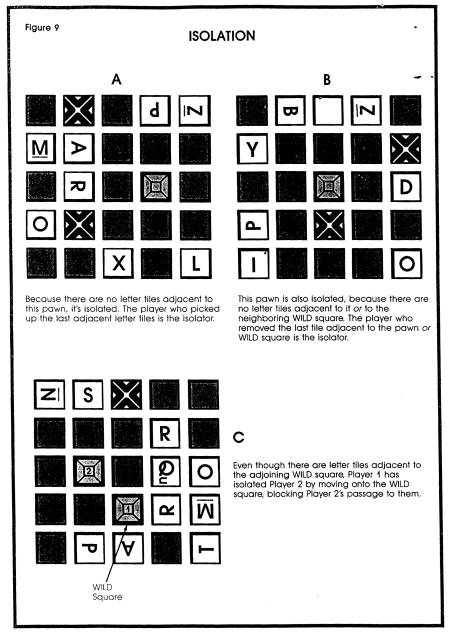
The player who isolates another player’s pawn immediately eliminates that player from the game, and gets a bonus for the isolation. As soon as the isolation occurs, the isolator removes the isolated pawn from the grid, and places it in his or her storage row. At the end of the game the isolator gets 5 points for every pawn isolated.
8. GETTING STRANDED: When either of the following two condillons occur, your pawn is stranded:
• SELF-ISOLATION: If you cut off your own pawn from any adjacent letter tiles, you’re stranded.
• NO WORD-MAKING OPTIONS: Even though there are letter files adjacent to your pawn you may not be able to make a word. Whether you or another player is responsible for this situation you're stranded.
If your pawn becomes stranded; you’re immediately out of the game. Take your pawn and set it aside, out of play. No player gets credit or bonus points for a stranded pawn.
9. THE LAST WORD—ENDING THE GAME: A bonus of 5 points is also awarded to the player who makes the last word. The player who makes the last word is able to do so by the process of elimination: as letter tiles are removed from the grid, players’ pawns become isolated or stranded, forcing them out of the game. Eventually, only one player is able to make a word. This last player can make as many “last words” as possible before becoming isolated. After the last player has made the very last word the game is over and all players total their respective scores.
10. SCORING—WHO WINS: After the game ends, all players calculate their total scores as follows:
Each letter tile = 1 point
Each isolated pawn = 5 bonus points
The last word = 5 bonus points
The player with the highest total score wins the game.
Game Variation
Here's a game variation for players who enjoy an extra challenge. In this game if you pick up any of the following letter tiles it counts as a bonus tile worth two points.J, Qu, V, X, and Z
When you remove one of these letter tiles from the grid, set it aside or place it in one of the compartments on the other end of your storage row. After the game, add 2 points to your score for each bonus tile used.
© 1985 by Milton Bradley Co. under Berne & Universal Copyright Conventions.
